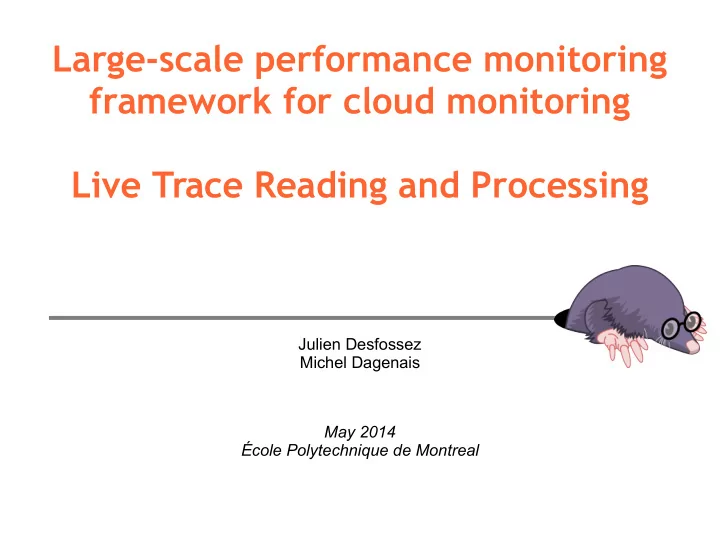

Large-scale performance monitoring framework for cloud monitoring Live Trace Reading and Processing Julien Desfossez Michel Dagenais May 2014 École Polytechnique de Montreal
Live Trace Reading ● Read the trace while it is being recorded ● Local or remote session ● Configurable flush period (live-timer) ● Merged into LTTng 2.4.0 ● Supported by Babeltrace 1.2 and LTTngTop ● Work in progress in TMF 2
Infrastructure integration Server Server Server (lttng-sessiond) (lttng-sessiond) (lttng-sessiond) TCP lttng-relayd TCP Viewer 3
Live streaming session On the server to trace : $ lttng create -–live 2000000 -U net://10.0.0.1 $ lttng enable-event -k sched_switch $ lttng enable-event -k –-syscall -a $ lttng start On the receiving server (10.0.0.1) : $ lttng-relayd -d On the viewer machine : $ lttngtop -r 10.0.0.1 Or $ babeltrace -i lttng-live net://10.0.0.1 4
What has been done since the last progress report meeting ● Bugfixing and release of LTTng 2.4.1 ● Graphite integration tests ● Stress/performance testing ● Started Zipkin/Tomograph integration to trace OpenStack (Python) ● Working with an GSoC intern on Babeltrace to Zipkin ● Sysadmin-oriented analyses prototypes (Python) ● Writing the paper about live tracing 5
Graphite Integration 6
Stress-testing setup ● 48 AMD Opteron(tm) Processor 6348 ● 512GB RAM ● 4x1TB SSD (1 for the OS, 1 for the VMs, 1 for the traces) ● Ubuntu 14.04 LTS ● Linux Kernel 3.13.0-16 ● LTTng Tools 2.4+ (git HEAD on March 10 th ) 7
Stress-testing ● 100 Ubuntu 12.04 VMs with 1GB RAM and 1 vCPU ● Streaming their traces to the host lttng-relayd with the live-timer of 5 seconds ● Tracing syscalls + sched_switch ● Running Sysbench OLTP (MySQL stress test) ● Measure overall impact on the system 8
100 Sysbench 9
Python analyses demo 10
Next steps ● Finish writing the paper ● Work on the architecture to process traces and extract metrics from large group of machines – Studying the large-scale infrastructures monitoring systems – Studying HTTP analytics on large-scale web infrastructures – Look at Facebook Scribe and integration with Hadoop HDFS – Continue prototyping with the Python libraries 11
Install it ● Packages for your distro ( lttng-modules, lttng-ust, lttng-tools, userspace- rcu, babeltrace ) ● For Ubuntu : PPA for daily build ( lttngtop ) ● Or from the source, see http://git.lttng.org 12
LTTng 2.5 features ● Save/Restore sessions – lttng save – lttng restore ● Configuration file (lttng.conf) – System-wide : /etc/lttng/lttng.conf – User-specific : $HOME/.lttng/lttng.conf – Run-time ● Perf UST ● User-defined modules on lttng-sessiond startup ● lttng --version with git commit id 13
Questions ? 14
Virtual machine CPU monitoring with Kernel Tracing Mohamad Gebai Michel Dagenais 15 May, 2014 École Polytechnique de Montreal
Content General objectives Current approaches Kernel tracing Trace synchronization Virtual Machine Analysis Execution flow recovery
General objectives Getting the state of a virtual machine at a certain point in time Quantifying the overhead added by virtualization Track the execution of processes inside a VM Aggregate information from host and guests Monitoring multiple VMs on a single host OS Finding performance setbacks due to resource sharing among VMs
Current approaches Top Steal time: percentage of vCPU preemption for the last second Does not reflect the effective load on the host 0% for idle VMs even if the physical CPU is busy Not enough information
Current approaches Perf kvm Information about VM exits, performance counters No information from inside the VM No information about VM interactions
Kernel tracing Trace scheduling events sched_switch for context switches sched_migrate_task for thread migration between CPUs (optional) sched_process_fork , sched_process_exit Trace VMENTRY and VMEXIT on the hypervisor (hardware virtualization) kvm_entry kvm_exit
Tracing virtual machines Each VM is a process Each vCPU is 1 thread Per-thread state can be rebuilt A vCPU can be in VMX root mode or VMX non-root mode A vCPU can be preempted on the host The VM can't know when it is preempted or in VMX root mode Processes in the VM seem to take more time Trace host and guests simultaneously
Trace synchronization Time difference between host and an idle VM
Trace synchronization Time difference between host and an active VM
Trace synchronization Based on the fully incremental convex hull synchronization algorithm 1-to-1 relation required between events from guest and host Tracepoint is added to the guest kernel Executed on the system timer interrupt softirq Triggers a hypercall which is traced on the host Resistant to vCPU migrations and time drifts
Trace synchronization Kernel module added to LTTng as an addon In the guest: Trigger a hypercall (event a ) On the host: Acknowledge the hypercall (event b ) Give control back to the guest (event c ) In the guest: Acknowledge the control (event d )
Trace synchronization Host and guest threads, as seen before.. ..and after synchronization
Trace synchronization Time difference between host and VM after synchronization
TMF Virtual Machine View Shows the state of each vCPU of a VM Aggregation of traces from the host and the guests 2 VM: Debian and Ubuntu vCPU 0 and vCPU 1 are complementary; fighting over the same pCPU
TMF Virtual Machine View Detailed information of execution inside the VM Process burnP6 (TID 2635) is deprived from the pCPU while the CPU time is still accounted for
TMF Virtual Machine View Shows latency introduced by the hypervisor (ie. emulation in KVM) to the nanosecond scale
Use case Periodic critical task Inexplicably takes longer on some executions 100% CPU usage from the guest's point of view
Use case VCPU is preempted on the host Invisible to the VM Duration of preemption is easily measurable
Execution flow recovery Build the execution flow centered around a certain task A List of execution intervals affecting the completion time of A Find the source of preemption across systems Example:
Execution flow recovery Previous example: Execution flow centered around task 3525:
Acknowledgements Ericsson CRSNG Professor Michel Dagenais Geneviève Bastien Francis Giraldeau DORSAL Lab
Recommend
More recommend